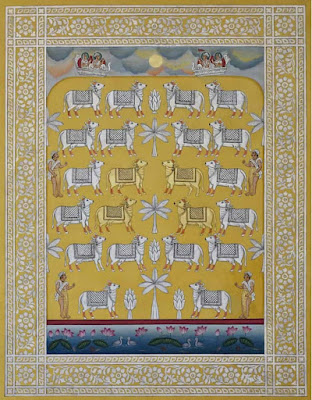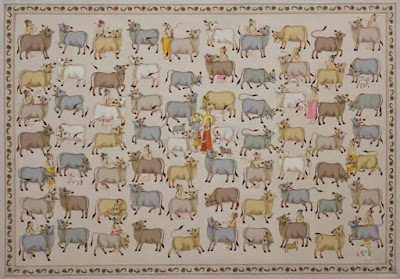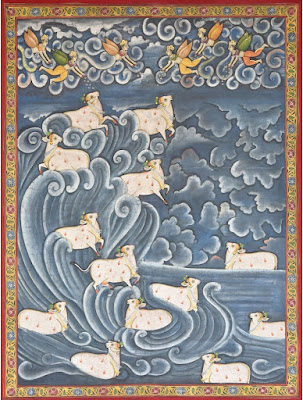Mastering Tradition: The Techniques and Stories Behind Cows Pichwai Art
Exploring the Intricate World of Cows Pichwai Art
Introduction to Cows Pichwai
Pichwai art, a traditional Indian form revered for its intricate details and profound spirituality, has captured the hearts of art enthusiasts worldwide. Originating from the Nathdwara region in Rajasthan over 400 years ago, Pichwai paintings were initially created to adorn the walls of temples, specifically to celebrate Lord Krishna. Among the various themes depicted in Pichwai art, the portrayal of cows holds a special place due to their sacred status in Hindu culture.
 |
| Silver and Golden Leaf Cows Pichwai |
Cows in Pichwai are not just animals; they are symbols of abundance, purity, and the earthly embodiment of various deities. This reverence is beautifully reflected in the art form, where each painting tells a story or conveys a spiritual message through symbolic elements interwoven with religious lore. The cow, often seen accompanying Lord Krishna, is depicted with as much care and detail as any divine figure, highlighting its importance in the narrative.
In this article, we delve deep into the world of Cows Pichwai, exploring its historical roots, the meticulous techniques employed by artists, and the rich symbolism that each painting carries. We will also look at notable artists and regions famous for this art form and discuss how Cows Pichwai continues to influence modern art and culture. Additionally, for enthusiasts eager to own a piece of this tradition, we will provide insights on where to find authentic Cows Pichwai artworks, including recommendations for reputable sources like Beyond Square, known for their quality and authenticity.
Artistic Techniques in Cows Pichwai
Pichwai painting, known for its rich detail and vibrant colors, is a craft honed over centuries, passed down from one generation of artisans to the next. Each Cows Pichwai artwork is a testament to the artist's dedication and skill, embodying techniques that require patience and precision.
Traditional Methods of Creating Pichwai Paintings
The process of creating a Pichwai starts with the preparation of the canvas, traditionally made from cloth. This cloth is first stiffened with a mixture of starch and clay, providing a smooth and firm surface. Once prepared, the canvas is then sketched upon, using a charcoal pencil to outline detailed scenes that often depict stories from the life of Lord Krishna and his association with cows.
Following the sketch, artists use natural colors derived from minerals, plants, and even precious stones to bring the drawings to life. These colors are applied with brushes made from the hair of squirrels, which are prized for their ability to hold fine pigments and deliver precise strokes. The choice of colors is significant; each hue holds symbolic meaning and is chosen to evoke specific sentiments in the viewer.
Detailed Look at the Materials and Tools Used
Traditional Pichwais are characterized by their use of specific materials that have been utilized for centuries. For instance, the brushes are not only made from squirrel hair but sometimes also incorporate horse hair for broader strokes. The pigments are a crucial element, with artists often using indigo for deep blues, ochre for earthy tones, and malachite for vibrant greens.
Gold and silver leaf are also commonly used in more elaborate pieces to add a touch of luminosity and grandeur, highlighting the divine aspect of the scenes depicted. The application of these metals is meticulous, often requiring the steadiness of hand that comes only from years of practice.
Step-by-Step Breakdown of the Painting Process
The painting process in Pichwai art is methodical and can take several weeks to months, depending on the complexity of the design. After the initial sketching and application of base colors, artists add layers of detail that include intricate patterns on the cows and background elements like flora, fauna, and architectural features.
Each layer is allowed to dry thoroughly before the next is applied, ensuring that the colors remain vibrant and distinct. The final step involves outlining the figures and motifs with darker tones to enhance depth and perspective, a technique that helps the key elements stand out and captivates the viewer's attention.
Through this meticulous process, Cows Pichwai paintings not only serve as decorative pieces but also as spiritual guides that offer a glimpse into the divine.
Iconography and Symbolism
Pichwai art is rich in symbolism, with each element carefully chosen to convey deeper spiritual truths. In Cows Pichwai, these symbols are not mere artistic expressions but serve as a medium to impart sacred teachings and stories of Hindu mythology, particularly those associated with Lord Krishna.
Analysis of Common Themes and Symbols Found in Cows Pichwai
Cows in Pichwai paintings are often depicted in serene, pastoral settings, symbolizing purity and peace. These gentle creatures are frequently shown in the company of Krishna, who is traditionally revered as a protector of cattle. This association underscores the cow's significance in Vedic texts where they are seen as sources of wealth and prosperity.
In addition to cows, other common elements in these paintings include lotus flowers, representing spiritual awakening; peacocks, symbolizing beauty and immortality; and the Govardhan mountain, which Krishna famously lifted to protect his followers. The intricate borders and vibrant backgrounds are not just decorative but are also filled with motifs that carry specific meanings, such as the use of blue to denote divinity and the eternal sky.
Interpretations of Various Elements and Their Spiritual Importance
The frequent depiction of cows with Krishna also highlights themes of devotion and protection. In many paintings, Krishna is shown playing his flute, with cows surrounding him, captivated by his music. This scene metaphorically represents how divine love draws the soul towards it, offering protection and enlightenment.
Furthermore, the pastoral scenes common in Cows Pichwai often include depictions of the Yamuna River, which is considered sacred in Hinduism. The presence of water bodies signifies life and fertility, creating a holistic representation of divine grace pervading the natural world.
 |
Radha Krishna and the Cows |
How Symbolism in Cows Pichwai Reflects Broader Hindu Traditions
The detailed artwork and symbolism in Cows Pichwai are a microcosm of broader Hindu religious practices, which emphasize the sanctity of nature and all living beings. By integrating these symbols, Pichwais teaches and reinforces cultural values and spiritual lessons that are central to Hindu philosophy.
These paintings not only serve as objects of worship and veneration but also as educational tools that transmit religious and cultural heritage across generations. They remind viewers of the deep interconnectedness between human life, nature, and the divine, urging a life of harmony and respect for all creation.
Notable Artists and Regions
Cows Pichwai art, with its detailed depiction of sacred cows and vibrant scenes from Lord Krishna’s life, is not just a form of artistic expression but also a cultural treasure preserved by skilled artisans. These artists, often hailing from families with generations in the craft, continue to keep this traditional art form alive.
Profiles of Prominent Pichwai Artists Who Specialize in Cow Depictions
The art of Pichwai has been nurtured in several regions, but it is perhaps most closely associated with the town of Nathdwara in Rajasthan. Here, artists like Venkatesh and his family have become renowned for their exquisite Cows Pichwai paintings. Venkatesh, a fourth-generation Pichwai artist, combines traditional techniques with his unique artistic vision, creating pieces that are both authentic and innovative.
Other notable artists include Priya and Mohan Sharma, siblings who have taken the art form to international exhibitions, showcasing the rich cultural heritage of India and expanding the audience for Pichwai. Their work, particularly focused on the serene and sacred depictions of cows, has garnered attention for its depth and emotional resonance.
Key Regions in India Where Cows Pichwai is Most Prevalent
While Nathdwara remains the heartland of Pichwai art, other regions such as Udaipur and Jaipur also contribute to its rich tapestry. These areas, known for their strong artistic communities, produce variations of Pichwai that reflect local traditions and influences. The artists in these regions often collaborate with local temples, creating custom pieces for religious festivities and ceremonies.
Differences in Style and Approach Between Various Schools of Pichwai
The style and approach to Pichwai can vary significantly from one region to another. Nathdwara’s style is often characterized by its meticulous attention to detail and vibrant color schemes. In contrast, the Udaipur style might incorporate more muted tones and focus on broader, sweeping landscapes.
These regional differences not only highlight the diversity within Pichwai art but also the adaptability of its artists to infuse local flavor while maintaining the spiritual and traditional essence of the art form.
Purchasing Authentic Cows Pichwai
For collectors and admirers of Pichwai art, acquiring an authentic piece is not just about owning a beautiful artwork; it's also an investment in preserving a piece of cultural heritage. Given the intricate craftsmanship and spiritual significance of Cows Pichwai paintings, knowing where to purchase these artworks is crucial.
Recommended Places to Buy Authentic Cows Pichwai Art
While there are many venues where one might find Pichwai paintings, specialty art galleries, and trusted online platforms are often the best places to start. These sources usually provide a certificate of authenticity and detailed information about the artwork’s origins, ensuring buyers receive genuine pieces.
One standout destination for purchasing Cows Pichwai and other forms of Pichwai art is "Beyond Square." Known for their dedication to authenticity and quality, Beyond Square collaborates directly with artisans from Nathdwara and other Pichwai centers, offering a bridge between traditional artistry and modern art collectors.
Special Highlight on "Beyond Square" as a Premier Destination
Beyond Square not only provides a wide range of Pichwai paintings but also supports the artists by facilitating workshops and exhibitions that help spread awareness of this unique art form. Their commitment to maintaining high standards makes them a preferred choice for serious collectors who seek both quality and authenticity.
Tips on Identifying and Purchasing Genuine Pichwai Art
When looking to purchase a Cows Pichwai painting, consider the following tips to ensure authenticity:
- Verify the Souce: Purchase reputable sources like Beyond Square.
- Examine the artwork: Authentic Pichwai paintings are characterized by their use of natural pigments and detailed brushwork. Be vary of pieces that use synthetic colors or show signs of mass production.
- Ask for Documentation: Reliable sellers should provide the history of the artwork, including information about the artists and the material used.
- Understand the Pricing: Genuine Pichwai paintings are priced based on their complexity, age, and the renown of the artists. Extremely low prices can be a red flag for counterfeit artwork.
By following these guidelines, buyers can make informed decisions and contribute to the sustainability of the Pichwai art tradition.
Impact on Modern Art and Culture
Cows Pichwai paintings, with their rich history and spiritual depth, have not only preserved traditional Indian art forms but also significantly influenced modern art and culture. As global interest in authentic and culturally rich artworks increases, Cows Pichwai has found new life in various contemporary contexts.
Influence of Cows Pichwai on Contemporary Art Forms
Contemporary artists are increasingly drawing inspiration from the traditional themes and techniques of Pichwai. This influence is evident in the adaptation of Pichwai motifs in modern paintings, installations, and digital art. Artists like Sanjay Bhattacharya and Seema Kohli have incorporated elements of Pichwai into their work, blending traditional Indian aesthetics with modern artistic styles to create unique and thought-provoking pieces.
Furthermore, the visual language of Cows Pichwai, particularly its vibrant colors and intricate details, has been adapted in fashion and home decor. Designers have used Pichwai patterns in fabric prints, apparel, and interior design elements, bringing a touch of traditional elegance to contemporary spaces.
Examples of Modern Adaptations in Other Media
In addition to visual arts, Pichwai themes have permeated other media such as film and literature, where its narratives and imagery are used to enrich storytelling. Filmmakers and authors have referenced Pichwai art to evoke a sense of the divine and to connect stories with Indian spiritual and cultural traditions.
Digital artists have also embraced Pichwai, using graphic design tools to recreate the intricate details and vibrant colors typical of the art form. These digital Pichwais make the art more accessible to a global audience, ensuring its preservation and relevance in the digital age.
The Future of Cows Pichwai and Its Role in Global Art Communities
As global cultural exchanges become more prevalent, the interest in and appreciation for Pichwai art continues to grow. This growing recognition not only promotes cultural diversity but also encourages the preservation of traditional arts, ensuring that they remain a vital part of our global heritage.
Exhibitions and workshops dedicated to Pichwai art around the world help educate people about its significance and provide a platform for traditional artists to gain international exposure. These initiatives ensure that Cows Pichwai remains relevant and appreciated not just as a relic of the past but as a living, evolving form of art.
Conclusion
Cows Pichwai art, a venerable tradition that dates back centuries, continues to captivate and inspire not only within its native India but around the world. This art form, with its deep roots in spiritual and cultural narratives, serves as a bridge connecting past and present, traditional and modern. As we have explored in this article, from the intricate techniques used in its creation to its impact on contemporary art and culture, Cows Pichwai embodies a timeless quality that transcends geographical and cultural boundaries.
The preservation of Cows Pichwai art is more than just the conservation of artistic techniques; it is the maintenance of a spiritual dialogue that has been ongoing for generations. By supporting artists and institutions like Beyond Square, which work tirelessly to keep these traditions alive, we contribute to the cultural richness of the future. Moreover, the integration of Pichwai themes into modern media demonstrates the versatility and enduring appeal of this art form, ensuring that its stories and symbols will continue to resonate with new audiences.
As Cows Pichwai art marches into the future, it carries with it the promise of innovation while staying rooted in its sacred origins. For collectors, admirers, and creators, Cows Pichwai is not just an investment in art but an investment in the spiritual and cultural tapestry of humanity. Let us cherish and sustain this beautiful art form, ensuring it thrives for generations to come.

.jpg)

Comments
Post a Comment